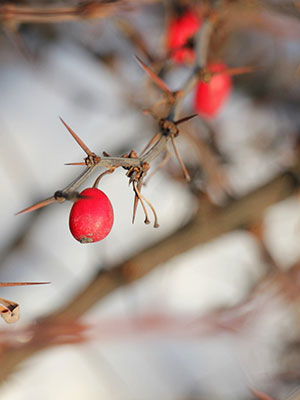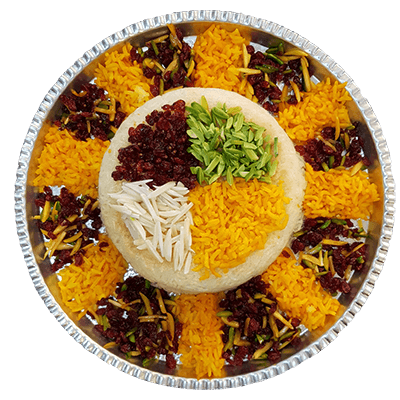
Fat (Per 100 gr)
35 g
Calories (Per 100 gr)
316 Kcal
Carbs (Per 100 gr)
63.9 g
Chol (Per 100 gr)
0 mg
Zereshk (Barberry)
Barberry tree is an evergreen tree with broad leaves and oval-shaped red fruits. Iran is the world's leading producer of this fruit and thus the world's leading exporter of this product. Iranian Barberry is famous all around the world and also known as “zereshk”. With an annual production of about 14,000 tons of Barberry, Iran is the first producer of that in the world. Barberry is a colorful and juicy fruit that has a sour taste. There are many different kinds of Iranian zereshk, the most popular are Puffy type, Pomegranate type, and Mountain Barberry. Iranian Barberry has been known for its medicinal use for over 200 years. It is a detoxifying plant that has excellent medicinal and sedative properties and helps treat several diseases.


How to use barberry?
Using Iranian Barberries in cooking
It is widely used in Iranian and Arabic cuisine. That is why it is found not only in Iranian grocery stores but also in Middle Eastern grocers in other countries, where they may be labeled under their Persian name, zereshk. It may seem strange that this product can grow in many Asian, European, and African countries. this fruit contains large amounts of protein.
Let's cook new food
Barberry stew is a new food that is very tasty and tastes special. If you are interested in new and specialty foods and would like to diversify your diet, be sure to try this stew. The stew has simple raw materials, but it is delicious and easy to make. It is also a favorite food for sour taste food fans.
This product has a special place in Iranian cuisine. Barberry is used in many dishes prepared for ceremonies and celebrations. There are many different Iranian dishes, including barberries in their recipes. For example in one of the certain wedding dishes which name is Zereshk-polo-Morgh (Barberries, saffron rice, chicken, and maybe some pistachio or almond slices) is very popular in Iran.
Planting and harvesting of Barberry
As mentioned earlier, Iran is the world's largest producer of this product. Iran not only produces the most of it in the world but also produces the highest quality barberry in the world. It is native to subtropical regions. It is cultivating in Iran in different parts of the country, including South Khorasan, Tehran, West Azarbaijan, Kerman and Isfahan provinces. In the province of South Khorasan in Iran, the largest amount of barberry in the world is cultivated. Iran produces 14,000 tons of it annually, making it the world's largest producer of barberry. One of the most important things to know about it's planting is that wheat rust is the main pest of barberry. This means that the farmers must not to plant near farmlands.
-
1
Planting
November, December
-
2
Harvesting
September, October

Barberry Types in Iran
Puffy type
This product is the most luxurious type of barberry in Iran and widely exported to other countries. Every year a large part of this product is exported to Europe and some Asian countries. Puffy type is more commonly used in the seasoning of foods, although it is also used medicinally. Puffy juice is found as a fruit juice in many stores.
Pomegranate type
This type of barberry has lower quality than Puffy type, which has led to customers looking to buy cheaper ones. This type is similar to pomegranate seeds, and because of this similarity, it is also called pomegranate barberry. After the beginning of the harvest season, the crop is removed from the tree by thin, tall trees. After harvesting, the products dried during the process. To dry barberry, it is spread on a cloth on the ground to be dried by sunlight. Puffy type has a lot of moisture compared to other types.
Mountain type
Black type grows in mountainous areas alongside rivers and wetlands. Unlike other types cultivated in South Khorasan, this type grows in northern parts of the country such as Bojnourd and Golestan forest margin and is, therefore less voluminous and scarce than other varieties. Its color is also more intense than the other two types.
Barberry Benefits
Zereshk is a rich source of vitamin C and also contains vitamin B, such as thiamine, and minerals such as zinc. In this fruit, there are chemical elements that are of great medicinal value. These chemical elements are used as an antibiotic to kill bacteria and fungi. It contains large amounts of antioxidants as well as B-complex vitamins. The following table shows the nutritional value of dried Iranian zereshk.
Impressive Health Benefits of Barberries
According to studies, berberine has antibacterial, antifungal, and antiprotozoal (protozoa) properties. To last longer, barberry is dried. After drying the product, it can be stored for a long time. Being dried (fresh ones are very hard to come by), they keep well, too. These wonderful fruits have many properties and are very good for health. Here are some properties of the Zereshk and its health benefits.
- Helps improve digestion and reduce gastrointestinal pain by helping the smooth muscles that cover the bowel.
- Can prevent infections by blocking the attachment of bacteria to human cells.
- It is advised that to help treat indigestion with liquid forms of barberry, such as juice or tea. Cleansing the liver and gallbladder is one of its benefits.
- It can also act as a laxative and regulate gastrointestinal processes with the help of bile secretion. In some cases, Zereshk is used traditionally to treat gallstones.
